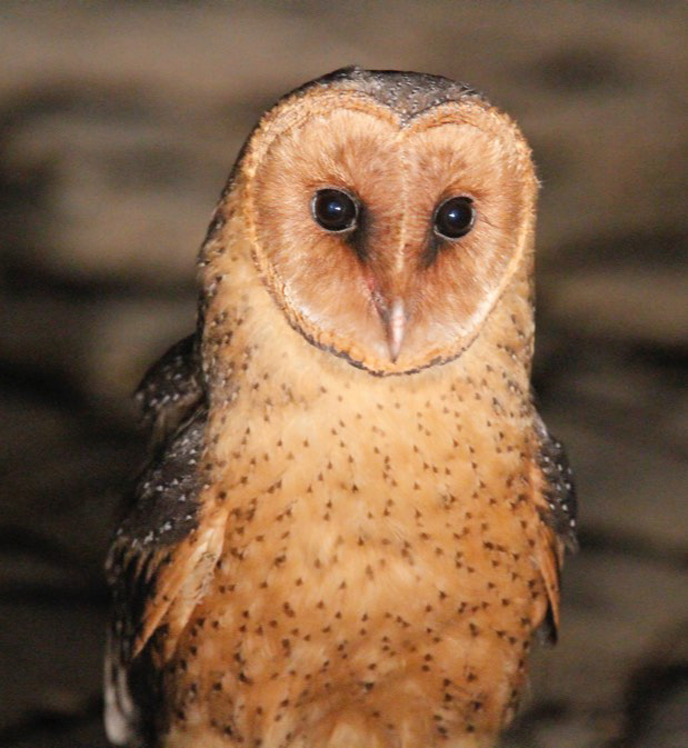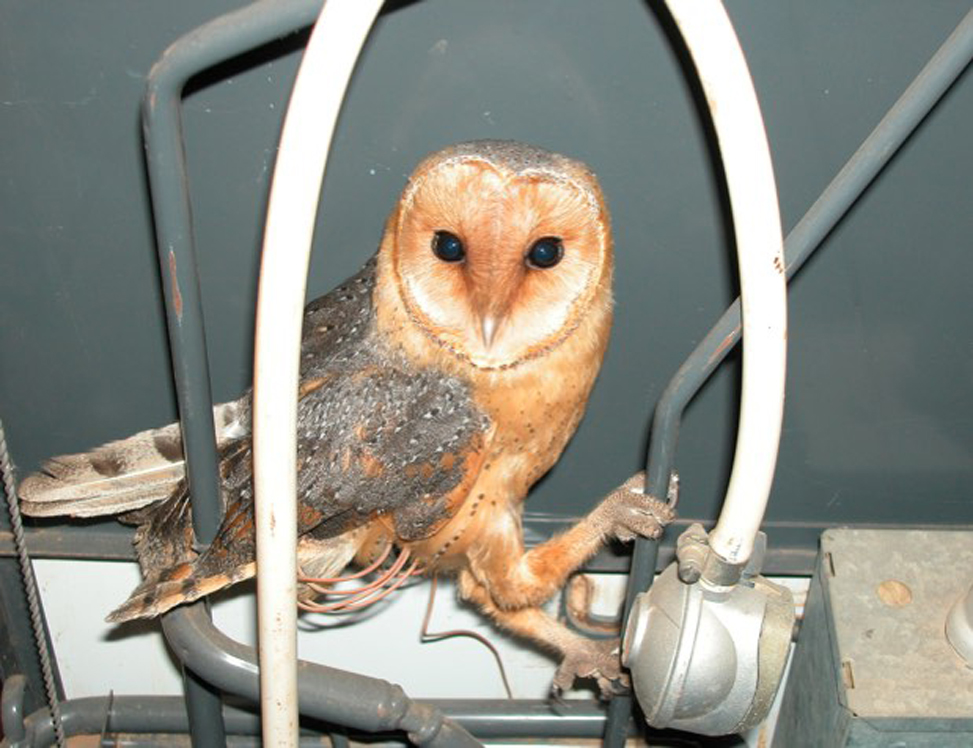Cape Verde Barn Owl Tyto detorta has a dark face, always. It is among the darkest of all barn owls. Compared to the darkest Common Barn Owls from Europe T alba guttata, its upperparts have larger white double spots and its flight feathers have more prominent dark bars (König et al 2008). Cape Verde is much darker than its nearest neighbour, African Barn Owl T alba affinis, which has a whitish facial disk. They do share other features, however, such as a large overall size with robust hunting and landing gear, and both have long and partly bare tarsi with heavy, bare toes (Cramp 1985).
Having such a distinctive appearance, Cape Verde Barn Owl has sometimes been treated as a separate species (eg, Hazevoet 1995) whereas the other two Macaronesian barn owls have barely received any attention. Other than plumage, there is actually nothing to suggest that Cape Verde has been isolated longer than the other two. All three differ morphologically from their mainland relatives, and two evolved in the complete absence of small mammals. The one furthest from any continent is actually Madeira Barn Owl T schmitzi, beating Cape Verde by a narrow margin.
Cape Verde Barn Owl’s perennial screeches can be either descending as in CD1-22 or ascending as in the first of CD1-23. I recorded both in the same valley, the focal point of a short expedition with René Pop. In 2007 I had found two cliff nests there while listening for shearwaters high on the steep slopes above. In November 2012 when I returned with René, the same two cliffs were hotspots of activity once again, but the owls were at a much earlier stage of breeding.
CD1-22: Cape Verde Barn Owl Tyto detorta Fontainhas, Santo Antão, Cape Verde Islands, 00:50, 28 November 2012. A single, downward-inflected perennial screech. 121128. MR.005055.01
CD1-23: Cape Verde Barn Owl Tyto detorta Fontainhas, Santo Antão, Cape Verde Islands, 23:36, 27 November 2012. Two upward-inflected perennial screeches. Background: African Common Toad Amietophrynus regularis. 121127.MR.233636.01

Cape Verde Barn Owl Tyto detorta, Barragem de Poilão, Santiago, Cape Verde Islands, 4 March 2012 (Eric Didner)
Fontainhas is well known as the first of several villages along Santo Antão’s most popular walking route. Europeans attract little attention unless they come at night, which I recommend. The valley is a good place to listen to some of Cape Verde’s nocturnal specialities, and I don’t just mean owls. A few Boyd’s Shearwaters Puffinus boydi breed there, and we heard Cape Verde Storm Petrels Oceanodroma jabejabe flying around the same cliffs as the barn owls (CD1-24). In the appropriate season, there are even a few Cape Verde Shearwaters Calonectris edwardsii.
CD1-24: Cape Verde Barn Owl Tyto detorta Fontainhas, Santo Antão, Cape Verde Islands, 18:36, 28 November 2012. A single, downward-inflected perennial screech. Background: Cape Verde Storm Petrel Oceanodroma jabejabe. 121128.MR.183626 & 121128.MR.204520.21
The storm petrels gave us our first clue about the owls’ menu. Another came from Emerson and Pedro, two young brothers who delivered hay to their goats every day, underneath one of the suspected nest sites. They told me an owl often perched on wires in the village from where it would swoop down on cockroaches. Ancient pellet accumulations on the island of Santa Luzia, once inhabited but now abandoned, parallel those of Slender-billed Barn Owl T gracilirostris. Older prey remains consist largely of endemic vertebrates – giant geckos Tarantola gigas but also a few of the now extinct giant skink Macroscincus coctei – until the owls switched their focus to a smaller gecko T caboverdiana and the introduced House Mouse Mus musculus (Siverio et al 2007).

Habitat of Cape Verde Barn Owl Tyto detorta, Fontainhas, Santo Antão, Cape Verde Islands, 27 November 2012 (René Pop). Same location as CD1-22 to 24 &
CD1-27 to 28.
I have been privileged to make several visits to the Cape Verde Islands, and my first took place in February 2004. Arnoud and I first heard and saw Cape Verde Barn Owl while recording Fea’s Petrels Pterodroma feae on São Nicolau. A few days later I recorded one giving a perennial screech on Santiago (CD1-25). In late March 2007 there were several fledged young in the same area, but I also heard courtship screeching of an adult male and soliciting calls of an adult female (CD1-26). The pair had already raised one brood and were apparently preparing to raise a second.
CD1-25: Cape Verde Barn Owl Tyto detorta São Jorge de Orgãos, Santiago, Cape Verde Islands, 25 February 2004. A single rising, modulated perennial screech. Background: cockerels. 04.007.MR.01055.03
CD1-26: Cape Verde Barn Owl Tyto detorta São Jorge de Orgãos, Santiago, Cape Verde Islands, 18:55, 26 March 2007. Courtship screeching of a male and soliciting calls of a female. Background: Grey-headed Kingfisher Halcyon leucocephala. 070326.MR.185540.30
Santo Antão is the lushest of the Cape Verde Islands, and perhaps the most laid-back. It is also my favourite, so the barn owls were a great excuse to go back. They did not give us an easy time. Although we found them in several locations we never managed to get a decent view, not even at Fontainhas. With two pairs present, there was often something to listen to.
CD1-27 has rivalry screams near and far, and some faint purring. We were too early for begging calls during that trip, so here are some juveniles from February 2007 (CD1-28). Working back in time, their mothers must have laid eggs no earlier than November the previous autumn.
CD1-27: Cape Verde Barn Owl Tyto detorta São Jorge de Orgãos, Santiago, Cape Verde Islands, 18:55, 26 March 2007. Courtship screeching of a male and soliciting calls of a female. Background: Grey-headed Kingfisher Halcyon leucocephala. 070326. MR.185540.30
CD1-28: Cape Verde Barn Owl Tyto detorta Fontainhas, Santo Antão, Cape Verde Islands, 21:33, 23 February 2007. Begging of a juvenile in the nest. 070223.MR.213321.11
Cape Verde Barn Owl’s breeding phenology is different from that of other Western Palearctic barn owls. Rainfall and ocean productivity, not temperature, determine when the owls breed. The Southwest Monsoon brings most of the year’s rainfall, if any, between August and October, so plants and animals that depend on it regenerate during the last few months of the year. On the largest island, Santiago, most females lay their clutch in mid to late October (de Naurois 1982). By contrast, pairs living on seabird islets breed when storm petrels are most abundant, which coincides with a peak in marine upwelling in early spring. On Branco, De Naurois found three freshly laid eggs on 8 March 1965, and on Ilhéu Grande, Geniez & López-Jurado (1998) found a recently vacated nest in mid-July.

Cape Verde Barn Owl Tyto detorta, Boavista, Cape Verde Islands, 25 May 2004 (Pedro Lopez Suarez)
Cape Verde Barn Owl is one of the least studied owls in the world. Ours are the first published recordings and only a handful of photographs exist. We could assume that Common Barn Owl is its closest relative, but the truth is that we don’t know. The even darker São Tomé Barn Owl T thomensis, an islander living virtually on the equator, is arguably the taxon it resembles the most. I’d love to travel another 3500 km southeast to investigate, but first I must head north. From the Tropic of Cancer to the boreal forests, from a virtual unknown to a species virtually squeezed dry by science, and from eerie screeches to far-carrying hoots.
